Enhancement of Microgrid Frequency Stability Based on the Combined Power-to-Hydrogen-to-Power Technology under High Penetration Renewable Units
Abstract
1. Introduction
- Proposing a new VSG method based on the SMES system to improve the frequency stability of ultra-low-inertia power grids while accounting for high levels of RES penetration.
- The suggested virtual controller (PI controller) is a composite of a virtual primary and virtual secondary controller.
- The solar power stations were divided into several small stations to restore stability of the μG at a high penetration level of RES and low load demand.
- Employing HESS to utilize the whole power generated from RES without power curtailment.
2. System Dynamics of an Isolated Microgrid
2.1. Deisel Engine Generator (DEG)
2.2. Photovoltaic System
2.3. Wind Turbines
2.4. Process Model of HESS
- Hydrogen production: electrolysis converts electrical energy to chemical energy.
- Hydrogen storage: refers to the chemical energy storage of hydrogen in a tank.
- Electricity generation: chemical energy converted to electrical energy via a [9].
2.4.1. Hydrogen Production—Electrolyzer
2.4.2. Micro GAS Turbines
2.5. Design of VIC Based on the SMES Device
Mathematical Model of SMES Device
3. Virtual Inertia Control System
4. Results and Discussions
4.1. Studied Scenarios
- —
- Scenario 1A: in this sub-scenario, the wind farm operates as a single station. Additionally, the PV generation system is controlled with load variation. Figure 9 shows the simulation results for scenario 1 under the high penetration level of the RES. The load demand profile changes with an average value of 689 kW, and the load demand values during different durations are as follows: 850 kW at 0 ≤ t ≤ 50 s, 610 kW at 50 ≤ t ≤ 100 s, 402.4 kW at 100 ≤ t ≤ 140 s, 730 kW at 140 ≤ t ≤ 180 s, 934 kW at 180 ≤ t ≤ 250 s, and 462.5 kW at 250 ≤ t ≤ 300 s, as shown in Figure 9a. The real irradiance profile for 24 h is acquired from Benban-Aswan, as illustrated in Figure 9b. In Figure 9c, the wind speed profile varies, with an average speed of 8 m/s under a turbulence intensity ratio of 20%. During the period 0 ≤ t ≤ 75 s, the amount of energy generated from the PV power stations is zero, as shown in Figure 9d. Moreover, the power generated from the diesel and the wind power station feeds the load, as illustrated in Figure 10e,f. So, the frequency deviation is zero, as shown in Figure 9g. During the period 75 ≤ t ≤ 212.5 s, this period represents the operating period of the PV power stations from 6 am to 5 pm. The amount of energy generated from solar power stations increases gradually, as shown in Figure 9d. However, when the amount of generation from solar power plants increases, the loses its frequency balance due to the low load demand and the large production of energy generated from PV power plants at t = 100 s. The deviation reaches 3 Hz, as depicted in Figure 9g. As a result, the power extracted from the wind power, the PV station, and the DEG reaches zero.
- —
- Scenario 1B: To eliminate the blackout of the , the solar power station is divided into several identical groups. Several groups are turned on or off according to the SMES storage capacity and load requirements. The load demand profile, wind speed profile, and solar irradiance profile are shown in Figure 9a–c. Figure 10 shows the simulation results for scenario 1B under the high penetration level of the RES. In this scenario, during the period 0 ≤ t ≤ 75 s, the amount of electricity produced by solar power plants is zero, as depicted in Figure 10a. Moreover, to maintain the stability of the microgrid and to keep the amount of change in frequency always at zero, as depicted in Figure 10d, a portion of the solar energy system is used to power loads, while another portion is isolated to ensure microgrid stability, as shown in Figure 10a. The electricity generated by the diesel and wind power stations feeds the load, as illustrated in Figure 10b.
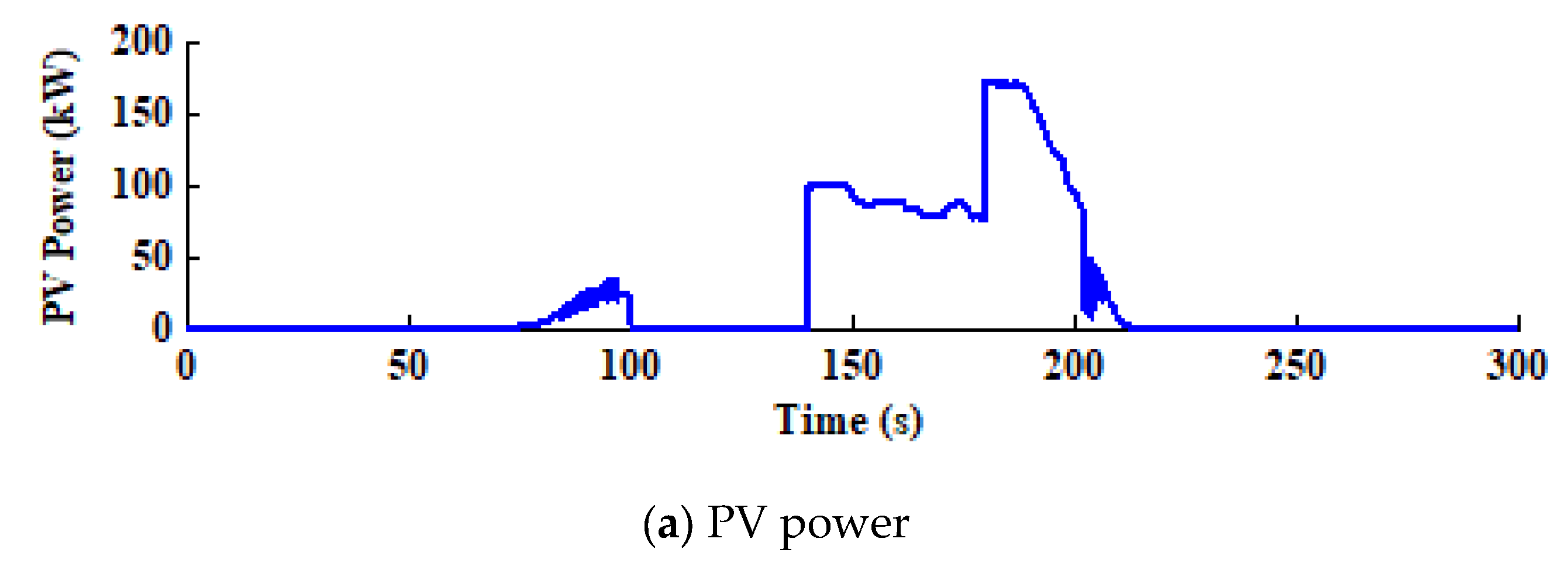

4.2. Comparative Study
5. Conclusions
Author Contributions
Funding
Data Availability Statement
Conflicts of Interest
Appendix A. System Parameters
| The coefficients C1 to C5 | ||
| Rated power |
| Rated power | |
| Pole pairs number | |
| Moment of inertia |
| = 3.53856 × | = 3.41025 × |
| = −3.0215 × | = 100 |
| = 0.45 | N = 2 |
| = 5.13093 | = 300 |
| = −2.40447 × | = 0.22369 |
| 250 | 1 | 1 | 1.08 | 0.03 | 10 | 0.1 | 3.0 | 1.0 | 8.22 | 0.1 | 1.2 |
|---|
| 0.001 | 0.4 kA | 0.003 s | 0.03 H | 12.1085 | 40.0908 | 0.614 |
References
- Zhou, D.; Al-Durra, A.; Zhang, K.; Ravey, A.; Gao, F. A robust prognostic indicator for renewable energy technologies: A novel error correction grey prediction model. IEEE Trans. Ind. Electron. 2019, 66, 9312–9325. [Google Scholar] [CrossRef]
- Kerdphol, T.; Rahman, F.S.; Mitani, Y.; Watanabe, M.; Küfeoǧlu, S.K. Robust virtual inertia control of an islanded microgrid considering high penetration of renewable energy. IEEE Access 2017, 6, 625–636. [Google Scholar] [CrossRef]
- Frack, P.F.; Mercado, P.E.; Molina, M.G. Extending the VISMA concept to improve the frequency stability in microgrids. In Proceedings of the 2015 18th International Conference on Intelligent System Application to Power Systems (ISAP), Porto, Portugal, 11–16 September 2015; pp. 1–6. [Google Scholar]
- Babahajiani, P.; Shafiee, Q.; Bevrani, H. Intelligent demand response contribution in frequency control of multi-area power systems. IEEE Trans. Smart Grid 2016, 9, 1282–1291. [Google Scholar] [CrossRef]
- Huang, L.; Xin, H.; Wang, Z. Damping low-frequency oscillations through VSC-HVDC stations operated as virtual synchronous machines. IEEE Trans. Power Electron. 2018, 34, 5803–5818. [Google Scholar] [CrossRef]
- Samanta, S.; Mishra, J.P.; Roy, B.K. Implementation of a virtual inertia control for inertia enhancement of a dc microgrid under both grid connected and isolated operation. Comput. Electr. Eng. 2019, 76, 283–298. [Google Scholar] [CrossRef]
- Hirase, Y.; Abe, K.; Sugimoto, K.; Sakimoto, K.; Bevrani, H.; Ise, T. A novel control approach for virtual synchronous generators to suppress frequency and voltage fluctuations in microgrids. Appl. Energy 2018, 210, 699–710. [Google Scholar] [CrossRef]
- Shi, R.; Zhang, X.; Hu, C.; Xu, H.; Gu, J.; Cao, W. Self-tuning virtual synchronous generator control for improving frequency stability in autonomous photovoltaic-diesel microgrids. J. Mod. Power Syst. Clean Energy 2018, 6, 482–494. [Google Scholar] [CrossRef]
- Díaz-González, F.; Sumper, A.; Gomis-Bellmunt, O.; Villafáfila-Robles, R. A review of energy storage technologies for wind power applications. Renew. Sustain. Energy Rev. 2012, 16, 2154–2171. [Google Scholar] [CrossRef]
- Shim, J.W.; Cho, Y.; Kim, S.-J.; Min, S.W.; Hur, K. Synergistic control of SMES and battery energy storage for enabling dispatchability of renewable energy sources. IEEE Trans. Appl. Supercond. 2013, 23, 5701205. [Google Scholar] [CrossRef]
- Onar, O.; Uzunoglu, M.; Alam, M. Dynamic modeling, design and simulation of a wind/fuel cell/ultra-capacitor-based hybrid power generation system. J. Power Sources 2006, 161, 707–722. [Google Scholar] [CrossRef]
- Jing, W.; Lai, C.H.; Wong, W.S.; Wong, M.D. Dynamic power allocation of battery-supercapacitor hybrid energy storage for standalone PV microgrid applications. Sustain. Energy Technol. Assess. 2017, 22, 55–64. [Google Scholar] [CrossRef]
- Aristidou, P.; Valverde, G.; Van Cutsem, T. Contribution of distribution network control to voltage stability: A case study. IEEE Trans. Smart Grid 2015, 8, 106–116. [Google Scholar] [CrossRef]
- Kerdphol, T.; Rahman, F.S.; Mitani, Y. Virtual inertia control application to enhance frequency stability of interconnected power systems with high renewable energy penetration. Energies 2018, 11, 981. [Google Scholar] [CrossRef]
- Mentesidi, K.; Garde, R.; Aguado, M.; Rikos, E. Implementation of a fuzzy logic controller for virtual inertia emulation. In Proceedings of the 2015 International Symposium on Smart Electric Distribution Systems and Technologies (EDST), Vienna, Austria, 8–11 September 2015; pp. 606–611. [Google Scholar]
- Hu, Y.; Wei, W.; Peng, Y.; Lei, J. Fuzzy virtual inertia control for virtual synchronous generator. In Proceedings of the 2016 35th Chinese Control Conference (CCC), Chengdu, China, 27–29 July 2016; pp. 8523–8527. [Google Scholar]
- Kerdphol, T.; Rahman, F.S.; Mitani, Y.; Hongesombut, K.; Küfeoğlu, S. Virtual inertia control-based model predictive control for microgrid frequency stabilization considering high renewable energy integration. Sustainability 2017, 9, 773. [Google Scholar] [CrossRef]
- Yan, R.; Saha, T.K. Frequency response estimation method for high wind penetration considering wind turbine frequency support functions. IET Renew. Power Gener. 2015, 9, 775–782. [Google Scholar] [CrossRef]
- Skiparev, V.; Machlev, R.; Chowdhury, N.R.; Levron, Y.; Petlenkov, E.; Belikov, J. Virtual inertia control methods in islanded microgrids. Energies 2021, 14, 1562. [Google Scholar] [CrossRef]
- Baxter, R.; Energy Storage in Today’s Power Market. Commodities 2002. Available online: http://www.energystoragecouncil.org (accessed on 20 March 2023).
- Dunn, B.; Kamath, H.; Tarascon, J.-M. Electrical energy storage for the grid: A battery of choices. Science. 2011, 334, 928–935. [Google Scholar] [CrossRef]
- Koohi-Fayegh, S.; Rosen, M.A. A review of energy storage types, applications and recent developments. J. Energy Storage 2020, 27, 101047. [Google Scholar] [CrossRef]
- Li, J.; Gee, A.M.; Zhang, M.; Yuan, W. Analysis of battery lifetime extension in a SMES-battery hybrid energy storage system using a novel battery lifetime model. Energy 2015, 86, 175–185. [Google Scholar] [CrossRef]
- Yang, H.; Li, Q.; Zhao, S.; Chen, W.; Liu, H. A hierarchical self-regulation control for economic operation of AC/DC hybrid microgrid with hydrogen energy storage system. IEEE Access 2019, 7, 89330–89341. [Google Scholar] [CrossRef]
- Liu, J.; Luo, W.; Yang, X.; Wu, L. Robust model-based fault diagnosis for PEM fuel cell air-feed system. IEEE Trans. Ind. Electron. 2016, 63, 3261–3270. [Google Scholar] [CrossRef]
- Li, Q.; Chen, W.; Liu, Z.; Li, M.; Ma, L. Development of energy management system based on a power sharing strategy for a fuel cell-battery-supercapacitor hybrid tramway. J. Power Sources 2015, 279, 267–280. [Google Scholar] [CrossRef]
- Fan, X.; Wang, X.; Yuan, W.; Li, C.M. Diethylenetriamine-Mediated Self-Assembly of Three-Dimensional Hierarchical Nanoporous CoP Nanoflowers/Pristine Graphene Interconnected Networks as Efficient Electrocatalysts toward Hydrogen Evolution. Sustain. Energy Fuels 2017, 1, 2172–2180. [Google Scholar] [CrossRef]
- Zhao, M.; Yuan, W.; Li, C.M. Controlled Self-Assembly of Ni Foam Supported Poly(Ethyleneimine)/Reduced Graphene Oxide Three-Dimensional Composite Electrodes with Remarkable Synergistic Effects for Efficient Oxygen Evolution. J. Mater. Chem. A 2017, 5, 1201–1210. [Google Scholar] [CrossRef]
- Yuan, J.; Li, C.; Li, T.; Jing, M.; Yuan, W.; Li, C.M. Remarkably Promoted Photoelectrochemical Water Oxidation on TiO2 Nanowire Arrays via Polymer-Mediated Self-Assembly of CoOx Nanoparticles. Sol. Energy Mater. Sol. Cells 2020, 207, 110349. [Google Scholar] [CrossRef]
- Garcia-Torres, F.; Bordons, C. Optimal economical schedule of hydrogen-based microgrids with hybrid storage using model predictive control. IEEE Trans. Ind. Electron. 2015, 62, 5195–5207. [Google Scholar] [CrossRef]
- You, S.; Hu, J.; Zong, Y.; Lin, J. Value assessment of hydrogen-based electrical energy storage in view of electricity spot market. J. Mod. Power Syst. Clean Energy 2016, 4, 626–635. [Google Scholar] [CrossRef]
- Cau, G.; Cocco, D.; Petrollese, M.; Kær, S.K.; Milan, C. Energy management strategy based on short-term generation scheduling for a renewable microgrid using a hydrogen storage system. Energy Convers. Manag. 2014, 87, 820–831. [Google Scholar] [CrossRef]
- Li, Q.; Wang, T.; Dai, C.; Chen, W.; Ma, L. Power management strategy based on adaptive droop control for a fuel cell-battery-supercapacitor hybrid tramway. IEEE Trans. Veh. Technol. 2017, 67, 5658–5670. [Google Scholar] [CrossRef]
- Mohamed, B.; Ali, B.; Ahmed, B.; Ahmed, B.; Salah, L.; Rachid, D. Study of hydrogen production by solar energy as tool of storing and utilization renewable energy for the desert areas. Int. J. Hydrogen Energy 2016, 41, 20788–20806. [Google Scholar] [CrossRef]
- Von Colbe, J.B.; Ares, J.-R.; Barale, J.; Baricco, M.; Buckley, C.; Capurso, G.; Gallandat, N.; Grant, D.M.; Guzik, M.N.; Jacob, I.; et al. Application of hydrides in hydrogen storage and compression: Achievements, outlook and perspectives. Int. J. Hydrogen Energy 2019, 44, 7780–7808. [Google Scholar] [CrossRef]
- Escamilla, A.; Sánchez, D.; García-Rodríguez, L. Assessment of power-to-power renewable energy storage based on the smart integration of hydrogen and micro gas turbine technologies. Int. J. Hydrogen Energy 2022, 47, 17505–17525. [Google Scholar] [CrossRef]
- Moazeni, F.; Khazaei, J. Electrochemical optimization and small-signal analysis of grid-connected polymer electrolyte membrane (PEM) fuel cells for renewable energy integration. Renew. Energy 2020, 155, 848–861. [Google Scholar] [CrossRef]
- Fragiacomo, P.; De, L.G.; Corigliano, O. Intermediate temperature solid oxide fuel cell/electrolyzer towards future large-scale production. Procedia Manuf. 2020, 42, 259–266. [Google Scholar] [CrossRef]
- Ursua, A.; Gandia, L.M.; Sanchis, P. Hydrogen production from water electrolysis: Current status and future trends. Proc. IEEE. 2011, 100, 410–426. [Google Scholar] [CrossRef]
- Khooban, M.H.; Niknam, T.; Blaabjerg, F.; Dragičević, T. A new load frequency control strategy for micro-grids with considering electrical vehicles. Electr. Power Syst. Res. 2017, 143, 585–598. [Google Scholar] [CrossRef]
- Ali, H.; Magdy, G.; Li, B.; Shabib, G.; Elbaset, A.A.; Xu, D.; Mitani, Y. A new frequency control strategy in an islanded microgrid using virtual inertia control-based coefficient diagram method. IEEE Access 2019, 7, 16979–16990. [Google Scholar] [CrossRef]
- Peng, F.Z.; Li, Y.W.; Tolbert, L.M. Control and protection of power electronics interfaced distributed generation systems in a customer-driven microgrid. In Proceedings of the 2009 IEEE Power & Energy Society General Meeting, Calgary, AB, Canada, 26–30 July 2009; pp. 1–8. [Google Scholar]
- Willis, H.L.; Scott, W.G. Distributed Power Generation: Planning and Evaluation; Marcel Dekker, Inc.: New York, NY, USA, 2000. [Google Scholar]
- Asif, M.; Iqbal, M. Diesel consumption in a high penetration remote hybrid power system with a pumped hydro and battery storage. In Proceedings of the 2013 IEEE Electrical Power & Energy Conference, Halifax, NS, Canada, 21–23 August 2013; pp. 1–6. [Google Scholar]
- Torres, M.; Lopes, L.A. An optimal virtual inertia controller to support frequency regulation in autonomous diesel power systems with high penetration of renewables. In Proceedings of the International Conference on Renewable Energies and Power Quality (ICREPQ 11), Las Palmas de Gran Canaria, Spain, 13–15 April 2011; pp. 13–15. [Google Scholar]
- Ulleberg, Ø. Modeling of advanced alkaline electrolyzers: A system simulation approach. Int. J. Hydrogen Energy 2003, 28, 21–33. [Google Scholar] [CrossRef]
- Martinez, D.; Zamora, R. MATLAB simscape model of an alkaline electrolyser and its simulation with a directly coupled PV module. Int. J. Renew. Energy Res. 2018, 8, 552–560. [Google Scholar]
- Jang, D.; Cho, H.-S.; Kang, S. Numerical modeling and analysis of the effect of pressure on the performance of an alkaline water electrolysis system. Appl. Energy 2021, 287, 116554. [Google Scholar] [CrossRef]
- Kim, M.J.; Kim, J.H.; Kim, T.S. Program development and simulation of dynamic operation of micro gas turbines. Appl. Therm. Eng. 2016, 108, 122–130. [Google Scholar] [CrossRef]
- Reale, F.; Sannino, R. Water and steam injection in micro gas turbine supplied by hydrogen enriched fuels: Numerical investigation and performance analysis. Int. J. Hydrogen Energy 2021, 46, 24366–24381. [Google Scholar] [CrossRef]
- Said, S.M.; Aly, M.; Hartmann, B.; Mohamed, E.A. Coordinated fuzzy logic-based virtual inertia controller and frequency relay scheme for reliable operation of low-inertia power system. IET Renew. Power Gener. 2021, 15, 1286–1300. [Google Scholar] [CrossRef]
- Othman, A.M.; El-Fergany, A.A. Adaptive virtual-inertia control and chicken swarm optimizer for frequency stability in power-grids penetrated by renewable energy sources. Neural Comput. Appl. 2021, 33, 2905–2918. [Google Scholar] [CrossRef]
- Alam, M.S.; Alotaibi, M.A.; Alam, M.A.; Hossain, M.A.; Shafiullah, M.; Al-Ismail, F.S.; Rashid, U.M.M.; Abido, M.A. High-level renewable energy integrated system frequency control with SMES-based optimized fractional order controller. Electronics 2021, 10, 511. [Google Scholar] [CrossRef]
- Colmenar-Santos, A.; Molina-Ibáñez, E.-L.; Rosales-Asensio, E.; López-Rey, Á. Technical approach for the inclusion of superconducting magnetic energy storage in a smart city. Energy 2018, 158, 1080–1091. [Google Scholar] [CrossRef]
- Li, D.; Zhu, Q.; Lin, S.; Bian, X. A self-adaptive inertia and damping combination control of VSG to support frequency stability. IEEE Trans. Energy Convers. 2016, 32, 397–398. [Google Scholar] [CrossRef]
- Sockeel, N.; Gafford, J.; Papari, B.; Mazzola, M. Virtual inertia emulator-based model predictive control for grid frequency regulation considering high penetration of inverter-based energy storage system. IEEE Trans. Sustain. Energy 2020, 11, 2932–2939. [Google Scholar] [CrossRef]



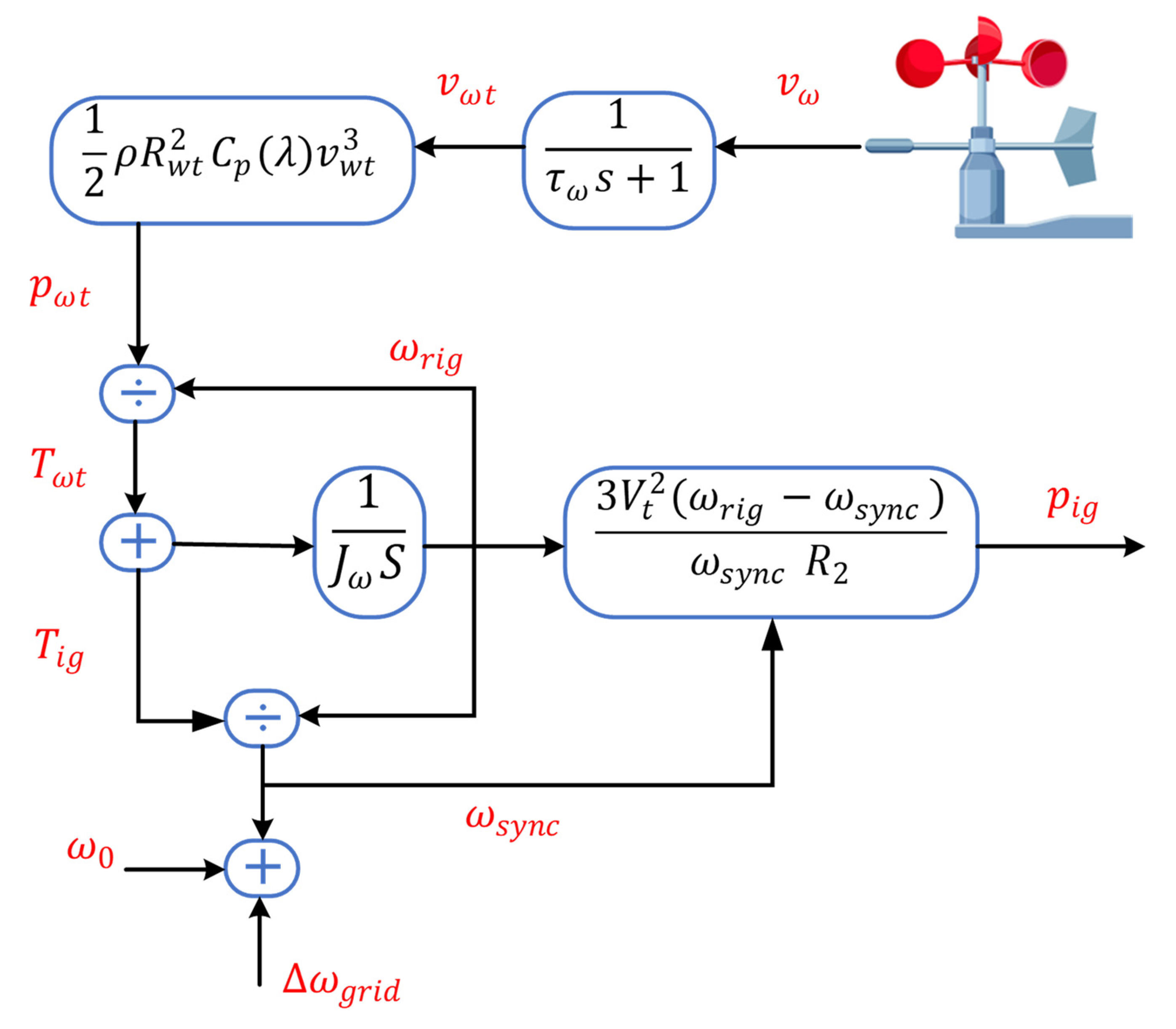
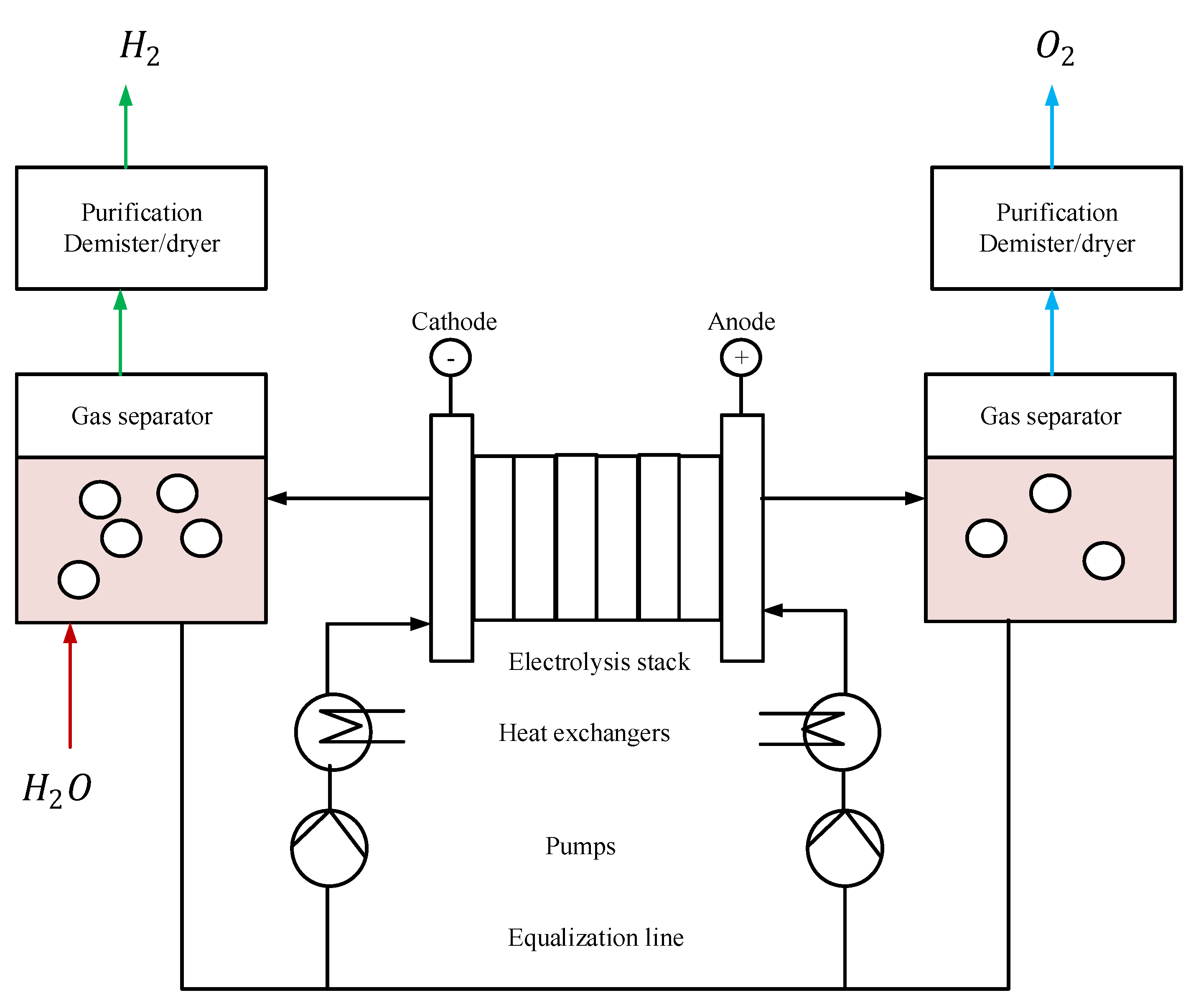


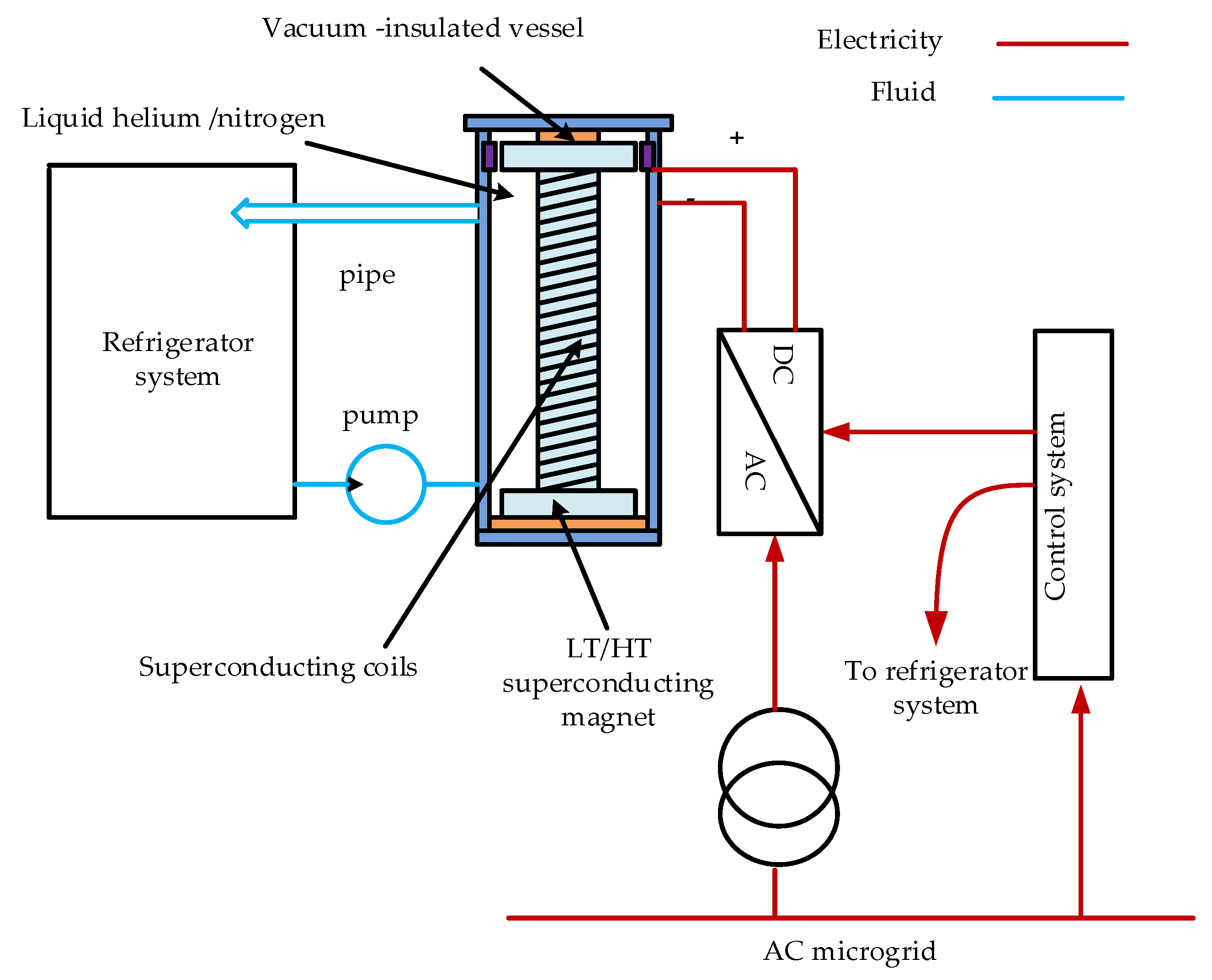

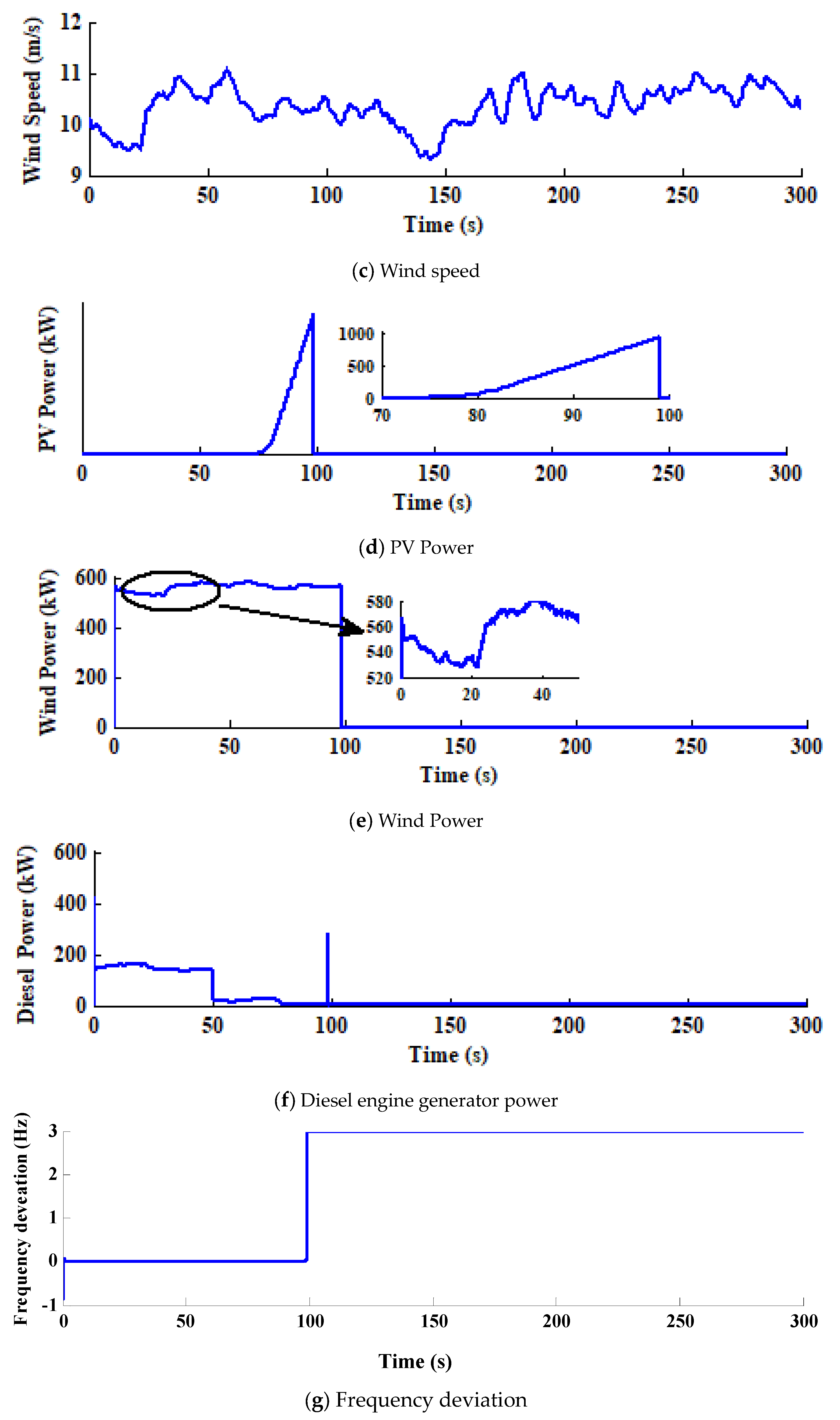

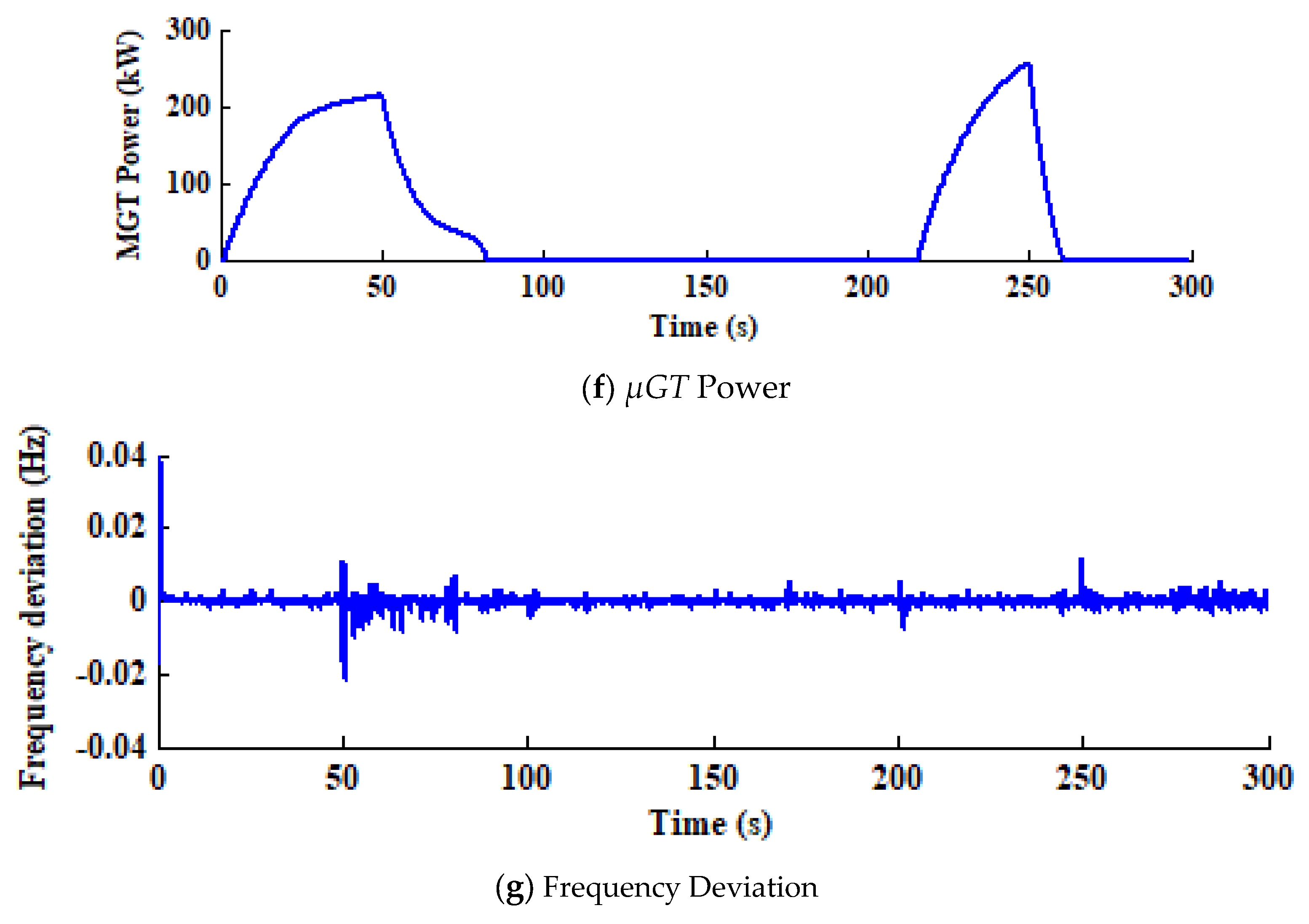
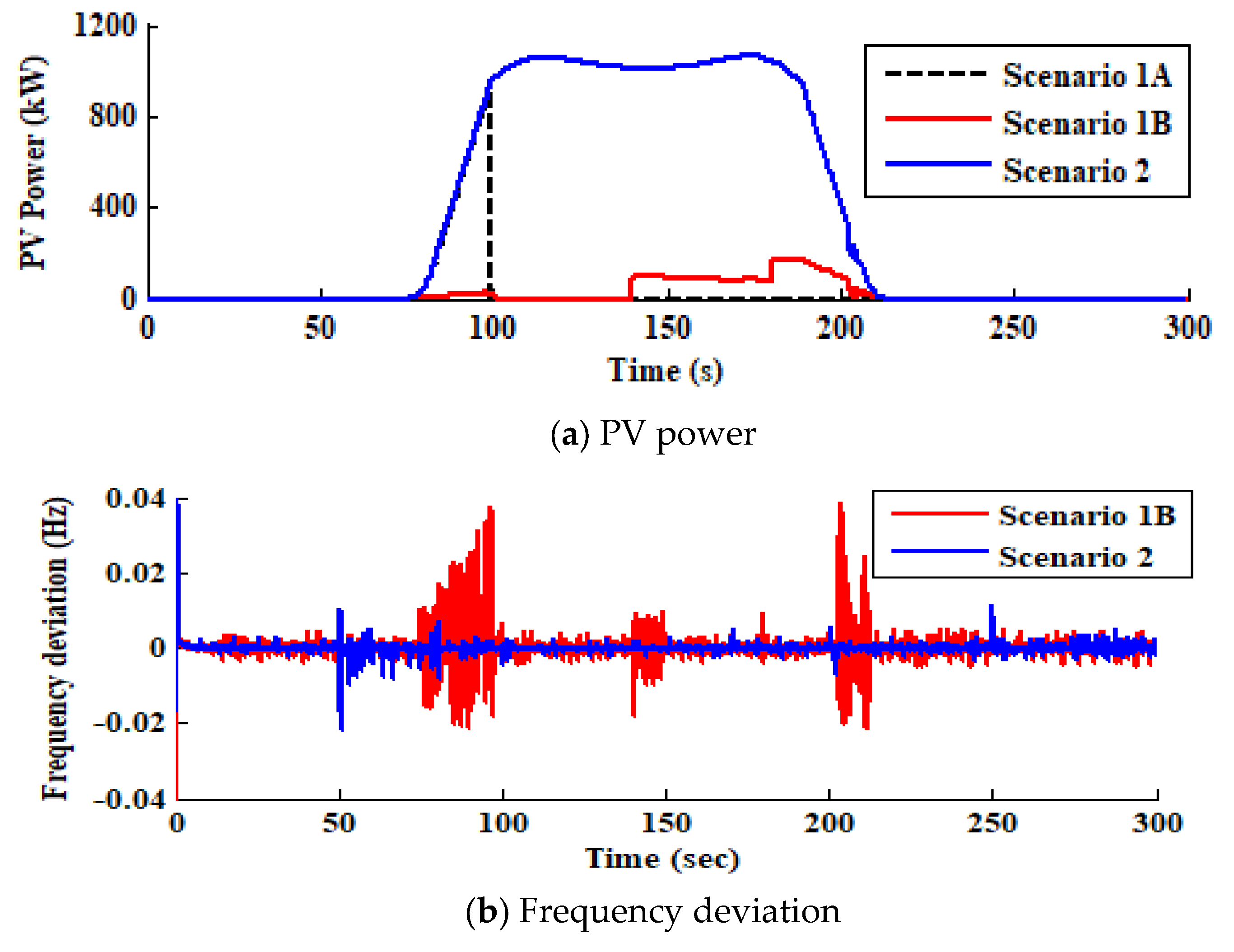
Disclaimer/Publisher’s Note: The statements, opinions and data contained in all publications are solely those of the individual author(s) and contributor(s) and not of MDPI and/or the editor(s). MDPI and/or the editor(s) disclaim responsibility for any injury to people or property resulting from any ideas, methods, instructions or products referred to in the content. |
© 2023 by the authors. Licensee MDPI, Basel, Switzerland. This article is an open access article distributed under the terms and conditions of the Creative Commons Attribution (CC BY) license (https://creativecommons.org/licenses/by/4.0/).
Share and Cite
Youssef, A.-R.; Mallah, M.; Ali, A.; Shaaban, M.F.; Mohamed, E.E.M. Enhancement of Microgrid Frequency Stability Based on the Combined Power-to-Hydrogen-to-Power Technology under High Penetration Renewable Units. Energies 2023, 16, 3377. https://doi.org/10.3390/en16083377
Youssef A-R, Mallah M, Ali A, Shaaban MF, Mohamed EEM. Enhancement of Microgrid Frequency Stability Based on the Combined Power-to-Hydrogen-to-Power Technology under High Penetration Renewable Units. Energies. 2023; 16(8):3377. https://doi.org/10.3390/en16083377
Chicago/Turabian StyleYoussef, Abdel-Raheem, Mohamad Mallah, Abdelfatah Ali, Mostafa F. Shaaban, and Essam E. M. Mohamed. 2023. "Enhancement of Microgrid Frequency Stability Based on the Combined Power-to-Hydrogen-to-Power Technology under High Penetration Renewable Units" Energies 16, no. 8: 3377. https://doi.org/10.3390/en16083377
APA StyleYoussef, A.-R., Mallah, M., Ali, A., Shaaban, M. F., & Mohamed, E. E. M. (2023). Enhancement of Microgrid Frequency Stability Based on the Combined Power-to-Hydrogen-to-Power Technology under High Penetration Renewable Units. Energies, 16(8), 3377. https://doi.org/10.3390/en16083377








